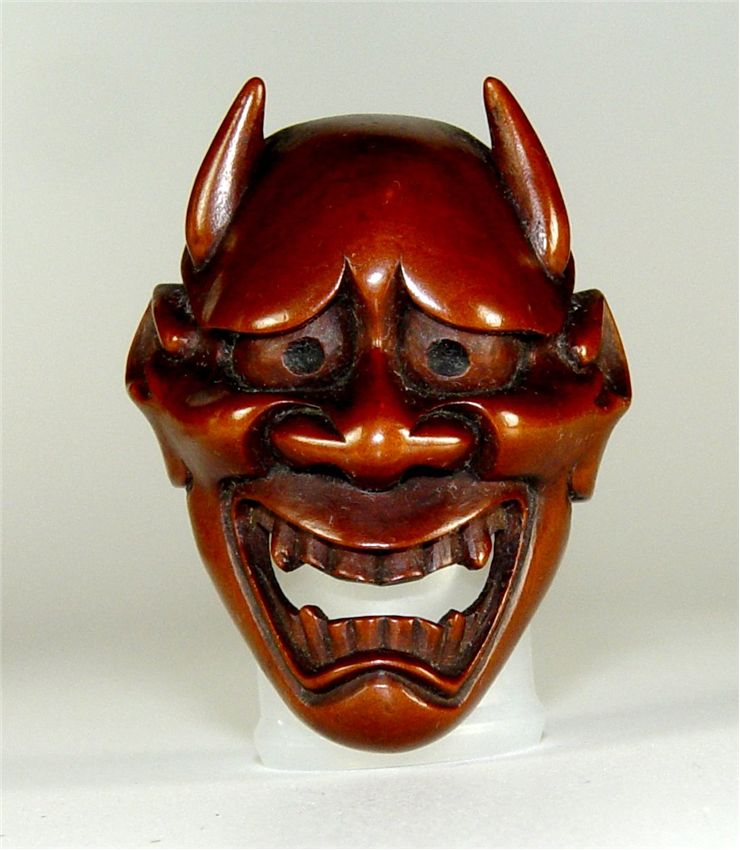Hannya - History and Meaning of Hannya Mask
Noh is classical Japanese musical drama based on tales from traditional literature performed since the 14th century. In the story, supernatural creature transforms into human shape and tells the story. The actors tell a story through gestures and appearance in masks. They capture the essence of the story.
Kyōgen is a form of traditional Japanese comic performance in the theater. It was performed as an intermission between Noh acts.
Shinto is an ethnic religion in Japan, and it focuses on ritual practices. Kagura is a type of Shinto theatrical dance.
The Hannya mask represents jealous female demon, serpent and sometimes dragon in noh and kyōgen Japanese traditional theater plays and Shinto Kagura ritual dances. The mask has a learing mouth, sharp teeth, metallic eyes (because it is not human) and two sharp devil-like horns. The first saved Hanna mask is from 1558. Hannya mask is one of the most recognizable masks in Noh plays.

This mask represents female rage and pain, and it is used when a particular character needs to be invoked. These two emotions are difficult to capture at the same time. It represents female obsessed with a devil or taking a devil form of being. The expression of Hannya mask is at the same time demonic, angry, frightening, dangerous and tormented, sad, heartbreaking, melancholic and sorrowful. She begins as normal female, but when she is betrayed, get angry and jealous she turns into a demon.
When the mask is held straight ahead, it looks angry. When the mask is held a little down it looks sad.
It's carved from a single piece of wood and often finished with very dark colored paint. It can be made for display or to wear it for performance. The mask is white if representing aristocratic status, red if representing low class and dark if representing demon. There are tree masks expressing the change in female emotions. The first mask expresses the jealousy, the second mask expresses a half way to the complete insanity, and the third mask is the saddest and expresses a female gone completely insane and converted into a demon.
In Japanese language hannya means wisdom. Some stories say that the mask got its name by monk artist Hannya, who perfected this mask and that he needed a great wisdom to make this mask. The perfection of transcendent wisdom is the perfect way of seeing the nature of reality so that you can protect yourself from the female demon.
Sometimes these masks are made to look happy from one angle and sad from another angle. It is also a Japan symbol of a good luck and it wards off the evil. Hannya Mask is popular tattoo motif.
In one play Prince Genji married to his wife Lady Aoi when he was young. He had a mistress Lady Rokujo. When Lady Aoi became pregnant, Genji began to ignore Lady Rokujo. In anger, Lady Rokujo’s spirit left her body, possessed Lady Aoi’s body and led to Lady Aoi’s death. So this story presented betrayed and angry women who transformed into Hannya demon.
One tail says that princess Kiyohime fell in love with passing by priest Anchin. He overcame his love for her. Her anger turned her into serpent or dragon, and she followed his. Anchin hid under the large bell of the temple. When Kiyohime found him, she breathed fire, melted the bell, and he died.
Another of the tails says that Hanna demon tormented people. One samurai, named Watanable no Tsuna, wanted to stop the creature. He waited for the creature to appear, but it was a beautiful young female. She asked him to escort her home. He saw her changing to Hanna and cut her arm with his sword. She vanished. The samurai took her arm home and locked it in a chest. Years later she visited his home disguised as his aunt, got her arm back and fled.
